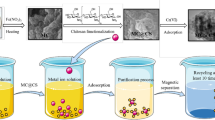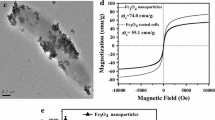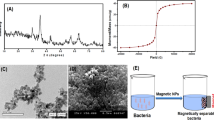Abstract
A sulfate-reducing Citrobacter strain was isolated and coated with Fe3O4/SiO2 magnetic nanoparticles (MNPs) to enhance sulfate reduction. Biolog analysis showed that it utilizes a broad range of electron donors. The findings also showed that this bacteria strain is a facultative anaerobe and can completely reduce 12 mM of sulfate to sulfide in 7 days under anaerobic conditions. Moreover, sulfate reduction was enhanced by 79% under optimized conditions. Different SiO2 wrap-ratios of the MNPs attached to the cell surface were studied to optimize the sulfate reduction: the surface of cells coated with 300% silica wrap-ratio MNPs showed the highest stability and increased desulfurization batch time, with a 450% increase in sulfate reduction in comparison with uncoated cells cultivated in anaerobic conditions.
Similar content being viewed by others
References
Muyzer, G. and A. M. Stams (2008) The ecology and biotechnology of sulphate-reducing bacteria. Nat. Rev. Microbiol. 6: 441–454.
Silva, A. J., M. B. Varesche, E. Foresti, and M. Zaiat (2002) Sulphate removal from industrial wastewater using a packed-bed anaerobic reactor. Proc. Biochem. 37: 927–935.
Kaster, K. M., A. Grigoriyan, G. Jenneman, and G. Voordouw (2007) Effect of nitrate and nitrite on sulphide production by two thermophilic, sulphate-reducing enrichments from an oil field in the North Sea. Appl. Microbiol. Biotechnol. 75: 195–203.
Hubert, C. and G. Voordouw (2007) Oil field souring control by nitrate-reducing Sulphurospirillum spp. That out compete sulfate-reducing bacteria for organic electron donors. Appl. Environ. Microbiol. 73: 2644–2652.
Wilms, R., H. Sass, B. Kopke, H. Cypionka, and B. Engelen (2007) Methane and sulphate profiles within the subsurface of a tidal flat are reflected by the distribution of sulphate-reducing bacteria and methanogenic archaea. FEMS. Microbiol. Ecol. 59: 611–621.
Stams, A. J., S. J. W. H. Elferink, and P. Westerman (2003) Metabolic interactions between methanogenic consortia and anaerobic respiring bacteria. Adv. Biochem. Eng. Biotechnol. 81: 31–56.
Luo, Y. D., C. A. Dai, and W. Y. Chiu (2008) Polystyrene/Fe3O4 composite latex via miniemulsion polymerization-nucleation mechanism and morphology. Polym. Chem. 46: 1014–1024.
Mangeney, C., M. Fertani, and S. Bousalem (2009) Magnetic Fe2O3-polystyrene/PPy core/shell particles: bio-reactivity and self-assemble. Langmuir. 23: 10940–10949.
Lellouche, J. P., G. Senthil, and A. Joseph (2005) Magnetically responsive carboxylated magnetite polydipyrrole/ polydicarbazole nanocomposites of core-shell morphology. Preparation, characterization, and use in DNA hybridization. J. Am. Chem. Soc. 127: 11998–12006.
Ashtari, P., X. X. He, K. Wang, and P. Gong (2005) An efficient method for recovery of target ssDNA based on amino-modified silica-coated magnetic nanoparticles. Talanta. 67: 548–554.
Rao, A. G., P. Ravichandra, J. Joseph, A. Jetty, and P. N. Sarma (2007) Microbial conversion of sulphur dioxide in flue gas to sulphide using bulk drug industry wastewater as an organic source by mixed cultures of sulphate reducing bacteria. J. Hazard. Mater. 147: 718–725.
Qiu, R. L., B. L. Zhao, J. L. Liu, and X. F. Huang (2009) Sulfate reduction and copper precipitation by a Citrobacter sp. isolated from a mining area. J. Hazard. Mater. 164: 1310–1315.
Roest, K., H. G. Heilig, H. Smidt, W. M. Vos, A. J. Stams, and A. D. Akkermans (2005) Community analysis of a full-scale anaerobic bioreactor treating paper mill wastewater. Syst. Appl. Microbiol. 28: 175–185.
Mogensen, G. L., K. U. Kjeldsen, and K. Ingvorsen (2005) Desulfovibrio aerotolerans sp. nov., an oxygen tolerant sulphate reducing bacterium isolated fromactivated sludge. Anaerobe. 11: 339–349.
Rees, G. N. and B. K. Patel (2001) Desulforegula conservatrix gen. nov., sp. nov., a long-chain fatty acid-oxidizing, sulfate-reducing bacterium isolated from sediments of a freshwater lake. Int. J. Syst. Bacteriol. 51: 1911–1916.
Author information
Authors and Affiliations
Corresponding author
Rights and permissions
About this article
Cite this article
Zhou, W., Yang, M., Song, Z. et al. Enhanced sulfate reduction by Citrobacter sp. coated with Fe3O4/SiO2 magnetic nanoparticles. Biotechnol Bioproc E 20, 117–123 (2015). https://doi.org/10.1007/s12257-014-0504-8
Received:
Revised:
Accepted:
Published:
Issue Date:
DOI: https://doi.org/10.1007/s12257-014-0504-8




